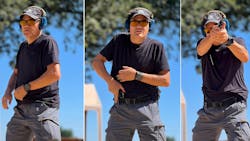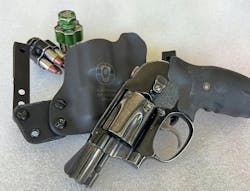Appendix Inside Waistband Carry: Choosing an AIWB System
Key Highlights
- Snubnose revolvers are more comfortable to carry and less intrusive when seated, making them ideal for off-duty concealed carry.
- Proper holster selection enhances retention, concealment, and quick deployment capabilities.
- Training with a shot timer and practicing draw techniques, such as foot positioning, can significantly improve response times in critical moments.
Most users think “medium-sized auto” when choosing an AIWB (appendix inside waistband carry) system. However, the snubby revolver may be the best and sometimes the safest choice. Here is some information on how to make it the best system to have in an emergency.
If you are looking for a “bottom line” in an article, here it is: The snubnose revolver is easier to carry than an auto AIWB, because it does not dig into the pelvic area when seated. A shooter can draw and fire one quicker by just when you carry AIWB, by just stepping back while drawing.
Off Duty is Different
When law enforcement officers train, it is predominantly with a full-size firearm, a duty belt with extra magazines, and the conventions of on duty practices. These practices include back up that is summoned by, and updated using a radio, a library of less lethal options, and the absence of nearby family members.
Off-duty is different. Resources are more limited, the officer is less likely, or even unlikely, to be carrying a duty sized gun, and most of the psychodynamic conditions in which we train do not exist. These psychodynamic conditions include the increased potential of cooperation a suspect might have to a uniformed officer, and possibly the fact that an off duty incident may also include a family member or friend.
Although agencies are doing this more often with more structure, we really don't train for off-duty encounters with a realistic approach.
Studies and position papers from representative organizations like the IACP suggest that an increase in legal actions against agencies concerning off-duty conduct has driven agencies to be more restrictive on their Officers’ discretion. This has been accompanied by several policy recommendations designed to restrict off duty powers of arrest. We could get into all kinds of arguments about the fact that a background and psychological examination is designed to establish the trustworthy discretion of the Officer, and therefore should trust this discretion.
Agencies need to train their officers for off duty. There are plenty of incidents where an off-duty officer has been forced to intervene in a situation, and many lives have been saved.
The value and danger of being at the right place at the right time has to be recognized.
Low Profile
When I train for concealed carry, I teach priorities:
Concealed carry is concealed carry. Letting another person know that your firearm is concealed could create massive implications off duty. One must maintain the balance between the most effective firearm and completely concealed posture.
One question I am sometimes asked is if it is healthy to let young family members know that the law enforcement member of the family is armed. This depends on the age of the kid, but generally no. As kids get older, the concept of having a Law Enforcement member in the family gets gradually integrated, and this is no longer an issue.
Quick deployment
In a grave situation, the person who delivers a decisive strike first has increased their survivability. This means “accurate” and “effective”. This must be balanced with the legality of their use of force. Faster is better. Anyone who hears Lindsey joke about off body carry will probably be offended if that is their method of carry. At this time, there is no off-body system that will compete with the speed of an AIWB, strong side IWB, or OWB system. Off body carry has its place, but users must incorporate strategies to make up for the loss in delivery.
Accurate delivery from a reliable platform
The firearm must be accurate and reliable. This has more to do with the user being able to shoot it well than the inherent accuracy of the gun. If you can’t shoot it well, do not waste your time with it.
Retention
You may be forced to fight or run with your holstered gun. You may need to re-holster a gun after drawing it. Your holster system must allow for some sort of retention.
Retention must also include an officer’s understanding of the need to have full control of the firearm they are carrying. If you show up at my range with an SOB (small of back) holster, we will have a detailed conversation about your deployment plan and how you intend to safeguard your firearm. After that, we will probably have another conversation about how you intend to draw your firearm without covering everyone else at the range with your muzzle.
Holster design is critical, and officers should be critical consumers.
Effective firearm
In the Twelve Rules of Off Duty Conduct (The February 2006 issue of LET), I wrote: Carry the most effective firearm the wardrobe will allow. I did not say “biggest” or “most powerful”. Lately, I have been carrying my Beretta 3032. In Summer, I wear running shorts. I know the limitations of this cartridge. I practice headshots all the time with it. I reload the 32 cartridge, and train a lot. I know how quickly I can deliver a sinus cavity shot. In some hands, it is not effective. The way to make a mouse gun effective is to train with it.
Taking a deep dive into off-duty activity goes far beyond the scope of this article. The statistics and studies of off-duty encounters aren't particularly complete. For example, off duty fatality numbers are almost completely restricted to LODD deaths that occur when off-duty officers intervene in an “on duty manner.” For example, FBI LEOKA (Law Enforcement Officers Killed and Assaulted) does have "off-duty" statistics, but they are gathered from "off duty but acting in an official capacity."
Why a revolver is a great choice
For AIWB I carry my Smith and Wesson Model 38. This is a 5-shot J-frame that weighs around 15 oz. I can shoot it accurately out to about 25 yards. Smith and Wesson offers a newer version in alloy and stainless steel, the Model 638. I prefer the shrouded hammer style, which allows both single and double action shooting. If you wish to go lighter, try a S&W 360 PD. This gun is a little too light for 357 Magnum, but it is designed for it. It weighs 11.8 oz. I recommend that you carry 357 when you need it and manage your expectations about recoil control. Practice with 38 Special.
I practice with my S&W Model 43c, an 11.4 oz, 8-shot, 22. The Model 43c fits almost any J-frame holster, and feels similar to my Model 38 without the recoil. I can practice almost any skill with it, even reloading, and the skill transfers to my Model 38. Using a 22 is cheaper, and doesn’t punish the user. Sometimes I carry the featherweight Model 43c when I am running or cycling.
The BlackPoint Tactical Mini Wing
I use a BlackPoint Tactical Mini Wing IWB holster, a minimalist set up with features that allow the user to customize the gun position and draw. The Mini Wing consists of a holster scabbard molded in two pieces. The attachment points are two leather wings on the bottom of the scabbard. The wings attach to the belt loops. BlackPoint Tactical offers different belt loop styles. The one I use has thin metal hooks, which go over the top and hook under the belt.
The design of the Mini Wing makes the holster “tuckable”. When fully tucked, only the two loops that suspend the holster can be seen.
One of the biggest complaints of AIWB is about having the gun barrel poking the user when he is sitting down.
One can configure the Tactical Mini Wing IWB holster by raising or lowering the belt loops, choosing a different loop or clip type, and by simply moving the mounting loops in or out. Even though this is a bikini-sized holster body, it allows for rapid re-holstering and retention suitable for EDC.
The Mini Wing has a built-in natural curve that contours the hips when mounted. Although it fully covers the trigger guard and cylinder, it is a tiny holster.
The BlackPoint Tactical Mini Wing IWB is the fastest threat response around, if you know how to set it up.
Make it Faster
When one draws from AIWB, the gun comes out of the holster parallel to the torso. The gun is drawn from the holster, muzzle down, flat part of the gun towards the target. In order to get the gun on target, the shooter has to orient it twice; first to make the gun vertical, where the grip is down, and the sighting plane is upright. Second, the gun needs to be brought up to the sighting plane.
Instead of having the flat of the gun parallel to the target, changing it to 45 degrees or more will make it, so the draw points it at the target with much less orientation. The trick is to slide the shooting side foot back when raising the gun from the holster. This moves the shooting side hip point back, while creating a more stable stance. As the Officer obtains the Master Grip, the shooting side foot goes back. This will blade the shooter to the target and reduce the amount of muzzle orientation.
The way to train for this is to use a shot timer. I use a Range Tech Shot Timer (https://www.officer.com/training-careers/training-equipment/article/21216762/the-rangetech-shot-timer-make-it-measurable) because my training partner can operate it, while the buzzer part is on my belt. If they are standing behind me, I have no visual cue when the buzzer will go off. My times are actually faster when I slide my shooting side foot back when drawing.
Train for off duty. Talk about off duty in your briefings. Stay in the fight.
About the Author

Officer Lindsey Bertomen (ret.), Contributing Editor
Lindsey Bertomen is a retired police officer and retired military small arms trainer. He teaches criminal justice at Hartnell College in Salinas, California, where serves as a POST administrator and firearms instructor. He also teaches civilian firearms classes, enjoys fly fishing, martial arts, and mountain biking. His articles have appeared in print and online for over two decades.

